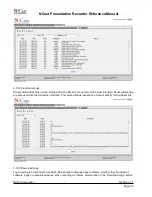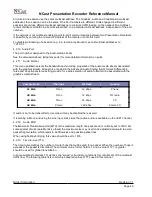
NCast Presentation Recorder Reference Manual
network transmission is acceptable, it is possible to disable this option to get extra low video latency. This is
a video encoder option - it doesn't affect the decoder.
4.2.20. Graphics Quantizer
These options set minimum and maximum video quality. The valid range is from 1 (best quality) to 31 (worst
quality). The default range is 2-31 for MPEG-4. For H.264 the range is 0-51 (default is 10-51). Decreasing
min quantizer will increase the maximum possible video quality, and increasing min quantizer will decrease
the maximum possible video quality. Increasing max quantizer will decrease minimum permitted video
quality. Increasing max quantizer too much may cause the encoder to skip frames in order to maintain the
target framerate. This is a video encoder option - it doesn't affect the decoder.
4.2.21. Graphics CBR Buffer
Sets the Constant Bit Rate buffer size in seconds. This controls how much the bit-rate can vary locally. A
larger buffer size results in higher overall video quality and less frame skips, but increases the video latency.
This is a video encoder option - it doesn't affect the decoder.
4.2.22. Audio Frames
Sets how many AAC frames can be sent in one packet. The default value is 8. The valid range is from 1 to
10. Lower values result in lower network jitter and lower latency, but higher network overhead (each packet
contains additional headers). Set to 1 to achieve extra low audio latency. This is an audio encoder option - it
doesn't affect the decoder.
4.2.23. Audio/Video Synchronization
This option is only visible if the Channel is set to “Full-duplex” or “Receive”. If enabled, audio and video is
synchronized during playback to maintain lip-sync (this is the default setting). If disabled, audio and video is
not synchronized during playback. In typical configuration audio will be played ahead of video. If lip-sync is
not needed, disable this option to get lower audio or video latency. This is a decoder option - it doesn't affect
the encoder.
4.2.24. Burst Video Playback
This option is only visible if the Channel is set to “Full-duplex” or “Receive” and is only available if
“Audio/Video Synchronization” is disabled. If enabled, the decoder forces video frames to playback
immediately after being received. This will result in lower video latency, but video playback will be jumpy due
to encoder and network jitter. If disabled, video frames are delayed to achieve smooth and fluid video
playback (this is the default setting). If jumpy video playback is acceptable, disable this option to get the
lowest video latency. This is a video decoder option - it doesn't affect the encoder.
4.3. C
HANNEL
S
ETTINGS
- R
ECORDING
4.3.1.
Recording Options
Three options are available for control of recording:
Manual – Recording must be started and stopped by the user via controls on the Session page or by
the room controller via one of the serial interfaces.
Auto – Recording starts and stops when the Session starts and stops.
Disabled – Recording is not permitted on this channel.
4.3.2.
Max Recording Time
The Maximum Recording Time specifies when a recording should be unconditionally stopped. This
value is used to prevent “runaway” recordings where the presenter forgets to press the Stop button
on the control panel interface and the unit might be left recording all weekend long. The time value is
in minutes and the default is 10 hours.
4.3.3.
Archive Filename
The default archived filename is of the form
NCast Corporation
Revision 1.1
Page 49
















































